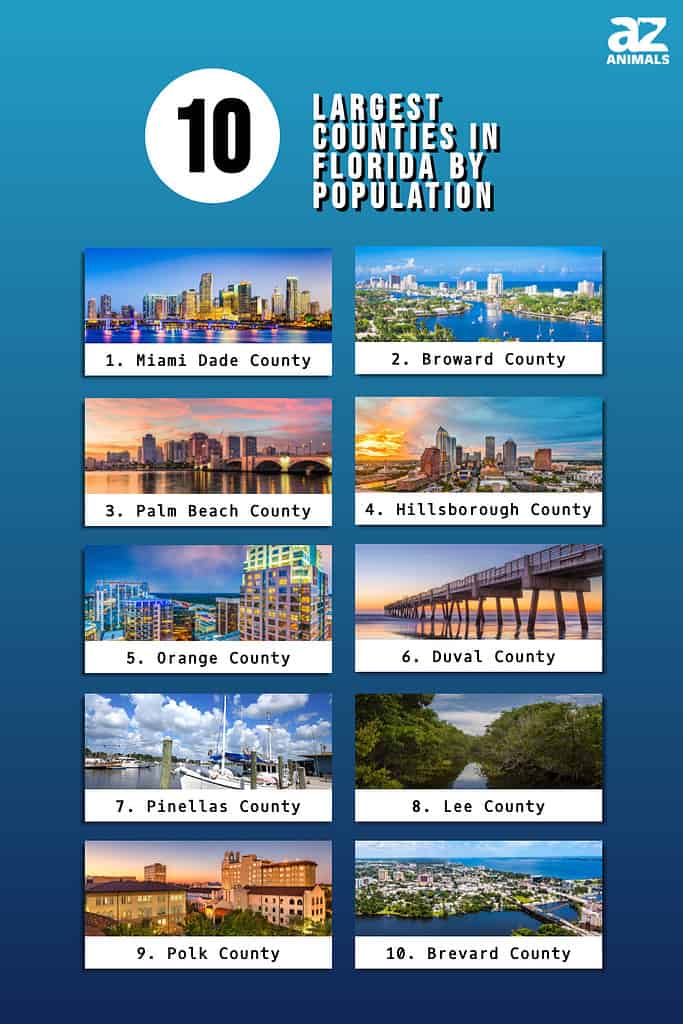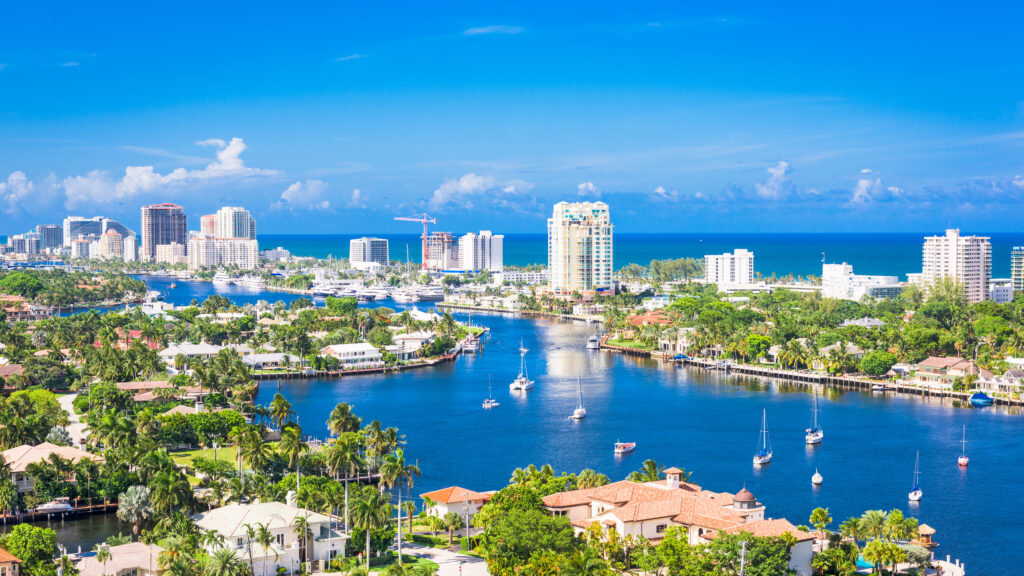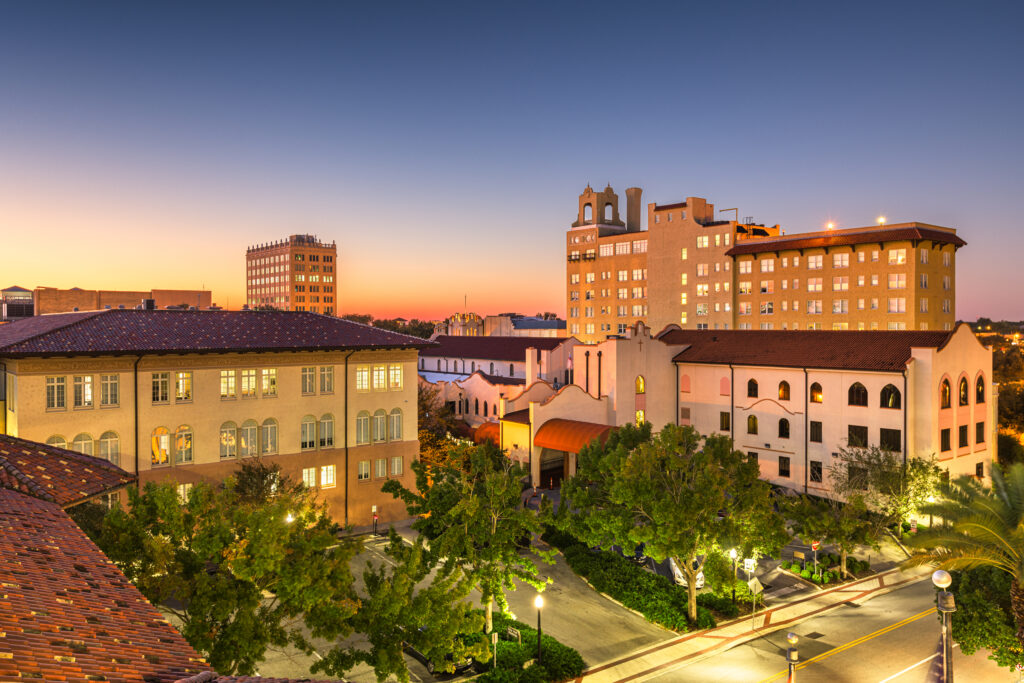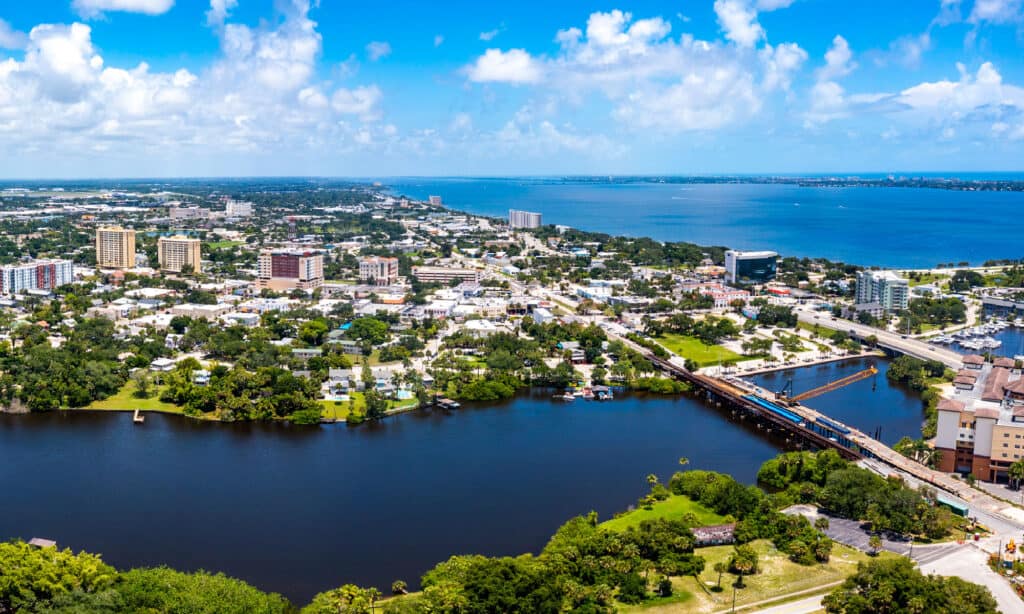When Wallet Hub analyzed the 50 states in the U.S. in 2022, focusing on 52 major factors of desirability from housing costs and wage growth to education rate and hospital competence, Florida was named the seventh best state to live in.
Florida received a total score of 58.07, with a six for the economy and a five for living conditions. However, the state’s affordability rating placed it in the bottom half at 33 and at 25 it ranked rather poorly in terms of health and education.
Florida has a lot to offer, whether you’re a big fan of Disney or just looking to retire in a state filled with sunshine and palm trees. If you’re considering making the move to the Sunshine State, we can help with a detailed look of the 10 most populated counties in the state.

1. Miami-Dade County
Miami-Dade County is situated in the southeast of Florida. According to the 2020 census, the area had a population of 2,701,767, ranking it as the most populated county in the state and the seventh-most populated county in the country.
Hispanics make up 68.5% of the population here. Black individuals make up 15.2% of the population in Miami-Dade County, followed by White at 13.3%. Miami-Dade County households earned a median family income of $57,815 in 2021.
Households in Miami-Dade County made a little more than those in Leon County and Volusia County. Yet, 12.5% of families in Miami-Dade County are poor. Residents of Miami-Dade County are 40.4 years old on average.
The area of Miami-Dade County is more than 2,000 square miles. Everglades National Park encompasses a third of Miami-Dade County. This area is situated on the Florida peninsula’s southeast coast. It is bordered to the east by Biscayne Bay and the Atlantic Ocean, to the west by Everglades National Park, to the south by the Florida Keys, and to the north by Broward County.

According to the 2020 census, Miami-Dade county ranked as the most populated county in Florida.
©iStock.com/SeanPavonePhoto
2. Broward County
Of the 67 counties in Florida, Broward County has the second-highest population with 1,934,551 residents. While Hillsborough County, with 1,444,359 residents, and Palm Beach County, with 1,481,233, are right behind Broward County.
The main racial/ethnic groupings in Broward County are White (34.2%), Hispanic (30.9%), and Black (27.6%). Households in Broward County earned a median annual income of $64,522 in 2021. Yet, 9.4% of families in Broward County are poor. Residents of Broward County are 40.7 years old on average.
The tourism business is flourishing in Broward County. With a tropical environment and an average annual temperature of 77 degrees, the region is a popular vacation spot for almost 10 million tourists each year, 2.4 million of whom come from abroad.

Fort Lauderdale is located in Broward County, Florida’s second-largest populated county.
©Sean Pavone/Shutterstock.com
3. Palm Beach County
Palm Beach County, one of 67 counties in Florida, has 1,481,233 residents, making it the third most populous county in the state. White individuals make up the majority in Palm Beach County (52.5%), followed by Hispanics (23.1%), and Blacks (18.2%).
Palm Beach County households’ average annual income in 2021 was $68,874. Nonetheless, 8.0% of households in Palm Beach County are below the poverty line. The average age of people living in Palm Beach County is 45.
Its agricultural output is the highest in the state, and after real estate development, farming is Palm Beach County’s second-largest industry. There is a sizable tropical agricultural production in the underdeveloped Palm Beach County, including greenhouses, truck crops, and sugar cane. Palm Beach County is called the nation’s “Winter Vegetable Capitol.”

West Palm Beach is located in Palm Beach County, which is called the nation’s “Winter Vegetable Capitol.”
©Sean Pavone/Shutterstock.com
4. Hillsborough County
Of 67 counties in Florida, Hillsborough County has 1,444,359 residents, making it the fourth most populous county in the state. The main racial demographic groups in Hillsborough County are White (47.0%), Hispanic (29.6%), and Black (15.5%).
The typical household income in Hillsborough County in 2021 was $64,164. However, 10.2% of families in Hillsborough County live in poverty. Residents of Hillsborough County are 37.6 years old on average.
The Spaniards were the first to survey and discover Hillsborough County, which bears the name of Wills Hill. Hill was the British Secretary of State to the Colonies from the late 1760s to 1772.
The County Center, the current administrative headquarters for the county, was inaugurated in 1994. In 2000, County Center was changed to be the Frederick B. Karl County Center in recognition of the County Administrator who played a key role in the building’s acquisition.

Tampa, Florida is located in Hillsborough County, the fourth most populous county in the state.
©iStock.com/Sean Pavone
5. Orange County
Orange County, one of Florida’s 67 counties, has 1,409,949 residents, making it the fifth most populous county in the state. The major racial/ethnic groupings in Orange County are White (38.2%), Hispanic (32.6%), and Black (19.5%).
Orange County families made $65,784 on average in 2021. Yet, 10.6% of households in Orange County are poor. The median age of residents in Orange County is 35.7 years old.
Orange County is among the most desirable places to reside, work, and raise a family because of its mild winters, abundant sunshine, world-famous destinations, and miles of neighboring beaches. Biking, hiking, horse riding, swimming, angling, tent and RV camping, and other outdoor pursuits are all examples of what one can do here.
Experience Orange County’s 100 parks, trails, and recreational areas, as well as the world-class museums, many cultural festivals, and dynamic urban lakes.

Orlando is located in Orange County, which has world-class museums, cultural festivals, and Walt Disney World.
©Sean Pavone/Shutterstock.com
6. Duval County
Among the 67 counties in Florida, Duval County has the sixth-highest population with 983,153 residents. Black (29.0%), Hispanic (10.6%), and White (50.8%) make up the three major racial/ethnic groups in Duval County.
The median family income in Duval County was $59,541 in 2021. The average age of people living in Duval County is 36.5.
Jacksonville is the seat of Duval County and the most populated city in Florida. With a land size of more than 840 square miles, it has the largest by acreage in the contiguous United States and is renowned for being one of the most military-friendly cities nationwide. There are numerous pubs, eateries, coffee shops, and parks in Duval County.

Jacksonville, the most populated city in Florida, is located in Duval County.
©Sean Pavone/Shutterstock.com
7. Pinellas County
Pinellas County is ranked as the seventh most populated county in Florida, with 961,739 residents. The main racial/ethnic groupings in Pinellas County are White (82.2%), Black (11.0%), and Hispanic (10.9%).
The typical household income in Pinellas County in 2021 was $60,451. It’s reported 7.4% of Pinellas County families live in poverty. The percentage of residents aged 65 years and older was 26.6% according to the 2022 census.
Pinellas County is the most densely populated county in Florida, with 3,425 people per square mile in the county. Its name comes from the Spanish “Punta Pinal,” meaning “point of pines,” which is what the land looked like when Spanish conquistador Panfilo de Narvaez came upon it in 1528.

Tarpon Springs is a historic Florida town in Pinellas County known for its sponges and Greek culture.
©Jillian Cain Photography/Shutterstock.com
8. Lee County
Lee County, one of many counties in Florida, has 752,251 residents, making it the eighth-most populous county in the state. Yet, Lee County needs to be on the lookout because Brevard County, with 601,573 residents, is close behind, followed by Polk County, with 713,148 residents.
Residents of Lee County are 48.9 years old on average. White (65.2%), Hispanic (22.6%), and Black (7.8%) are the three racial/ethnic groups that make up the majority in Lee County. Households in Lee County made a median income of $63,235 in 2021. Families in Lee County earned marginally more money than those in the vicinity. Yet, 8.4% of families in Lee County live in poverty.
Southwest Florida’s tourism hub and county seat is Fort Myers. At the confluence of the Caloosahatchee River and the Gulf of Mexico, it is located approximately 120 miles south of Tampa. Major League Baseball teams the Boston Red Sox and Minnesota Twins have their spring training in Lee County.

Lee County’s J.N. “Ding” Darling National Wildlife Refuge preserves more than 245 species of birds.
©iStock.com/DimitrisTimpilis
9. Polk County
Polk County ranks as Florida’s ninth most populous county with 713,148 residents. Here, citizens are 40.1 years old on average. This county’s households’ median annual income in 2021 was $55,099.
Nonetheless, poverty is present in 11.1% of Polk County families. White (56.0%) and Hispanic (24.9%) are the two largest racial/ethnic groupings in Polk County, followed by Black (14.5%). Currently, Polk County plays a significant role in the state’s politics and economy.
The local economy continues to be heavily dependent on the industries of citrus, livestock, agriculture, and phosphate, as well as on rising visitor spending in recent years.

Lakeland, Florida is located in Polk, County. It relies on citrus, livestock, and agriculture.
©Sean Pavone/Shutterstock.com
10. Brevard County
The three largest racial/ethnic groupings in Brevard County are White (72.8%), Hispanic (11.0%), and Black (9.1%). Residents of Brevard County are 47.0 years old on average. Brevard County ranks as Florida’s tenth most populous county with 601,573 residents.
Brevard County families earned a median family income of $63,632 in 2021. The poverty rate in Brevard County is 7.2%, though. Most people in Brevard County are homeowners. There are numerous pubs, eateries, coffee shops, and playgrounds in Brevard County. Brevard County has a large population of seniors and young professionals, and its citizens are generally conservative.

Indian River Lagoon is located in Brevard County, Florida.
©iStock.com/Stephen Wood
Summary of Largest Counties in Florida by Population
Here’s a recap of Florida’s most populated counties that we took a close look at.
| Number | County | Population |
|---|---|---|
| 1 | Miami-Dade County | 2,701,767 |
| 2 | Broward County | 1,934,551 |
| 3 | Palm Beach County | 1,481,233 |
| 4 | Hillsborough County | 1,444,359 |
| 5 | Orange County | 1,409,949 |
| 6 | Duval County | 983,153 |
| 7 | Pinellas County | 961,739 |
| 8 | Lee County | 752,251 |
| 9 | Polk County | 713,148 |
| 10 | Brevard County | 601,573 |
The photo featured at the top of this post is © iStock.com/SeanPavonePhoto
Thank you for reading! Have some feedback for us? Contact the AZ Animals editorial team.






